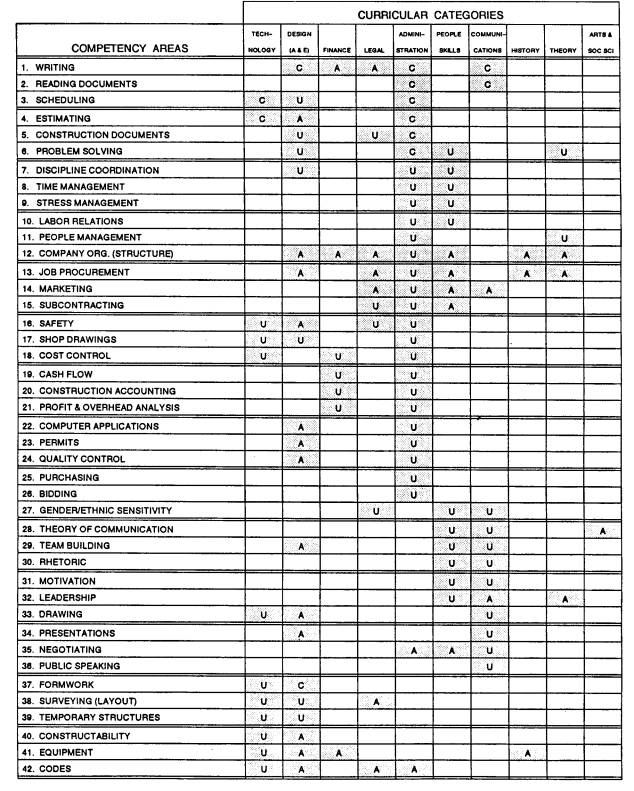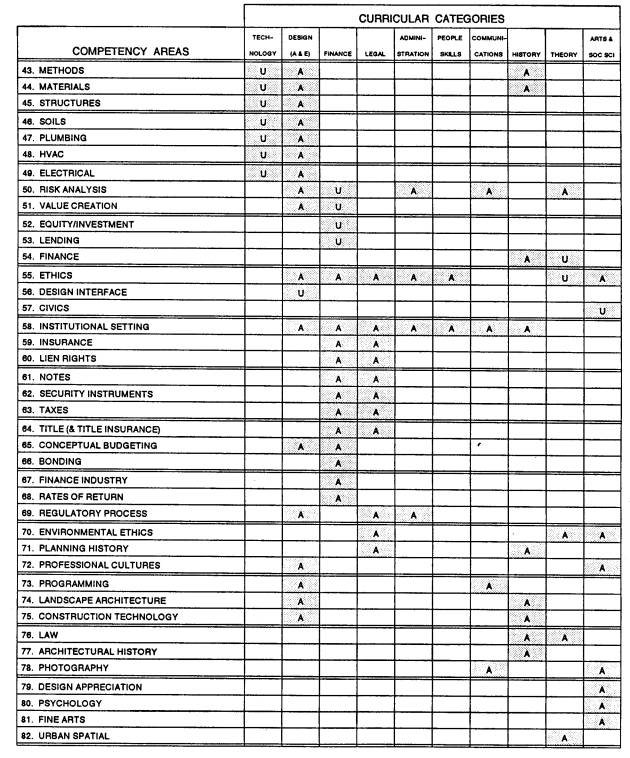(pressing HOME will start a new search)
- ASC Proceedings of the 27th Annual Conference
- Brigham Young University-Provo, Utah
- April 18-20, 1991 pp 65-70
|
(pressing HOME will start a new search)
|
|
COMPETENCIES
FOR CONSTRUCTORS: AN ALTERNATIVE APPROACH TO CURRICULUM DEVELOPMENT
|
| The
criteria and standards used to evaluate Construction curricula have been
discussed and debated for several years, particularly with regard to the
accreditation process. The current standards being utilized by the
American Council for Construction Education (ACCE) distribute courses
into five categories, establishing a minimum number of credit hours for
each. These delineations can become rather arbitrary, producing either a
distorted or incomplete assessment of a program's curriculum and course
content. As
members of the University of Washington's Building Construction
Curriculum Committee, we are currently developing an alternative
methodology for review of curriculum and course content. A matrix of
proposed competency areas for our construction graduates has been
completed, and statements are now being formulated for each area.
Following a review by industry and alumni representatives, these will be
used to evaluate the current course offerings to assure that all
competencies are being addressed. This
paper chronicles the progress made to date. In addition, it sets out the
parameters to be followed in completing what has turned out to be a
rather significant undertaking. |
INTRODUCTION
Faculty,
administrators, and accrediting bodies all grapple with the common question of
how to evaluate curricula of degree programs. In most cases, this is
accomplished by a set of criteria and standards developed either by the program
itself or an accreditation board.
Once established, it is fairly common for review criteria to be treated
as though they were cast in stone, with little consideration being given to
their review and modification.
On
of the goals listed in the ACCE's Standards and Criteria for Baccalaureate
Programs/Form 103 is to "review at regular intervals the criteria and
standards which ACCE has adopted to evaluate programs in construction
education." This is in line with the objective expressed in the Associated
Schools of Construction's Bylaws to "innovate, improve, and adjust
curricula, educational and teaching processes, and instructional materials to
meet changing conditions."
The
purpose of this paper is to describe an alternative evaluation method to that
currently used by ACCE in the accreditation process. It is currently in the
formative stages, and therefore will require additional review and refinement.
Via this process, the Department has embarked on the most comprehensive
evaluation of curriculum and course content that has been attempted in its
twenty-seven year history. This paper describes the methodology we are
following, and gives an example of the competency statements being developed.
This evaluation method should be given consideration by the ACCE for
incorporation into the accreditation criteria and standards for Construction
programs.
BACKGROUND
The
quantitative approach to curriculum evaluation is based on the assumption that
if a sufficient number of courses are taken by a student in designated areas of
study, the student will have obtained (or at least have been exposed to) the
knowledge necessary to obtain his/her degree. While this is a fairly common
approach utilized by accreditors and administrators of many different degrees,
the difficulty applying it to Construction curricula lies with the number of
disciplines which are gathered together under the Construction umbrella. This
makes the matching of courses to categories difficult and arbitrary, and leads
to inevitable disagreements in the assessment process.
While
it is true that the accreditation process used by ACCE goes beyond this
quantitative approach in its evaluation of the quality of courses and
qualifications of instructors, "credit counting" remains a
less-than-precise way of assessing whether true balance is being achieved by a
particular program. This is not to imply that this shortcoming has flawed the
accreditation process of those programs currently accredited by ACCE. It is,
however, entirely possible that both current and future candidates for
accreditation may be handicapped in their attempts to respond to the existing
criteria.
Much
of the debate regarding categorization of courses has revolved around
distinctions between construction science, business and management, and
construction. Often the category a course is placed in is determined by who
teaches the course, or more precisely, under which department it is offered. At
its 1990 annual meeting, ACCE added Item (f) to topics under the
"Construction" category, broadening it to include "applications
of business fundamentals, such as
construction
law, construction accounting, etc." A statement was also added to the
"Business and Management" section noting that "applications of
these (business) fundamentals to construction should be included in category 5
(f)".
While
fundamental courses are desirable, business and management courses tailored to
the needs of future constructors are an invaluable addition to the curriculum.
The real question to be considered is whether the course is being taught from a
technician or a manager's viewpoint. A construction accounting course taught by
a bookkeeper for a construction company will probably result in the course
receiving a "technician's" slant; the same course taught by a CPA or
CFO for a construction company will lean heavily toward managerial accounting.
The University of Washington has labored for many years to bring certain
business and management courses into the Building Construction program in order
to supplement the business school's "generic approach" with
industry-specific information. Competent professionals have been recruited to
teach these courses, thus providing insights into the business side of
construction which the program's graduates would not otherwise have.
Several
different methods of curriculum review have emerged from the different
disciplines related to Construction. The methodology established by the National
Architectural Accrediting Board (NAAB) was chosen as a model for the development
of this alternative approach to analyzing and improving the Construction
curriculum at the University of Washington. It utilizes
"achievement-oriented performance criteria" for the evaluation of
program content and student performance, assessing knowledge and skill
acquisition in terms of awareness, understanding, and ability (which has been
modified in our system tocapability ). The mechanics of this process are
described below.
METHODOLOGY
The
methodology we are following in the development of our alternative approach to
curriculum review is detailed below:
The resulting matrix is found in the appendix entitled "Proposed Competency Areas for Program Guidelines."
[Note:
We are currently at this step in the process.]
|
COMPETENCY STATEMENTS
The
critical element in the process described above is the development of competency
statements. These need to be both specific and assessable to serve as an
evaluative tool. Properly written, they will reflect the value which the faculty
places in the item, along with its relative weight within the overall
curriculum. Competency statements must also be realistic in terms of what can be
accomplished within the constraints of the program.
The
three levels of competency are further defined below:
|
1)
Capability - At this level, a graduate should be able to function
with little or no assistance, and with only general supervision. 2)
Understanding - At this level, a graduate should understand how
something is done, and be able to accomplish it with some assistance and
under direct supervision. 3)
Awareness - At this level, a graduate has been exposed to the
concept or skill, but does not possess sufficient knowledge or
understanding to function without additional instruction or experience. |
To
be of greatest use and to aid in their development, competency statements should
be grouped by curricular category, such as the example for scheduling below.
COMPETENCY STATEMENTS: SCHEDULING
In
the Administration Category, a BCon graduate should: - Be capable of reading and
analyzing schedules.
| -
Understand the use of schedules to manage day-to-day operations of a
company and its projects.
-
Understand the use of schedules to plan future work activities. -
Understand different types/hierarchies of schedules. -
Understand how schedules are implemented by project managers and
superintendents. -
Understand how and when schedules need to be updated. -
Understand the use of schedules in preparing claims. |
In
the Technology Category, a BCon graduate should:
|
- Be capable of analyzing a residential or light commercial project and determining its sequence of construction activities. -
Be capable of creating a bar chart for a residential or light commercial
project. -
Be capable of producing a precedence diagram for a residential or light
commercial project. - Be capable of producing an activity-on-arrow diagram for a residential or light commercial project. -
Understand how a short-interval schedule is created and used. -
Understand how to construct an "as-built" and
"but-for" schedule and what they are used for. -
Understand how to assign and level resources for a given schedule. -
Understand how to construct a cash flow schedule and "S"-curve. |
In
the Design Category, a BCon graduate should:
| -
Understand the relationship between design and construction function
relative to a project schedule.
-
Be aware of the constraints imposed on a project schedule by the design
and approval/permit process |
CONCLUSION
We
have established the structure and organization for our new model, and have
begun formulating competency statements. This task will be time-consuming,
especially in light of the number of areas of competency we have established.
This
process has been very worthwhile in itself, irrespective of results.
It is not presented as a prescription, but as something which seems to be
working for us, fitting both our psychological make-up and our vision for this
program. This paper should be viewed as input to other programs and the
accreditation standards. We encourage each of you to forward comments,
criticisms and additions. We have already received a draft from Cal Poly SLO of
curriculum elements including several competency areas which could easily be
added to our matrix. And, at the 1991 ACCE midyear board meeting, President
Roger Liska presented his thoughts on competency-based standards--including
forty-six examples of objectives--to accredited program directors.
In
the end, the efficacy of our model will be validated by the applicability of the
competency statements, measured both internally and externally.
REFERENCES
1.
American Council for Construction Education, Annual Reports 1989. 1990, Monroe,
Louisiana.
2.
ACCE, Standards and Criteria for Baccalaureate Programs (Form 103), 1990.
3.
Associated Schools of Construction, Annual Report and Minutes of the
Twenty-Sixth General Meeting, Peoria, Illinois, 1990.
4.
Liska, Roger, Competency-Based Curriculum Standards: Does ACCE Want to Move in
This Direction?, ACCE midyear board meeting, February 1991.
5.
Morrill, Paul and Spees, Emil R., The Academic Profession: Teaching in Higher
Education, New York, 1982.
UNIVERSITY
OF WASHINGTON - DEPARTMENT OF BUILDING CONSTRUCTION PROPOSED COMPETENCY AREAS
FOR PROGRAM GRADUATES
(VERSION
3 UPDATED FROM DISCUSSION ON 12/26/90)
C-CAPABILITY, U=UNDERSTANDING, A-AWARENESS

UNIVERSITY
OF WASHINGTON - DEPARTMENT OF BUILDING CONSTRUCTION PROPOSED COMPETENCY AREAS
FOR PROGRAM GRADUATES - PAGE 2
(VERSION
3 UPDATED FROM DISCUSSION ON 12/26/90)
C=CAPABILITY, U=UNDERSTANDING, A-AWARENESS
